Third Assignment: Labour Relations and Employment Law in Canada
VerifiedAdded on 2020/04/15
|8
|1687
|72
Report
AI Summary
This report provides an analysis of labour relations and employment law in Canada, focusing on workplace grievances and the rights of unionized employees. It examines the roles of managers and HR advisors in handling employee termination, including the application of Weingarten rights. The report explores the concept of wilful misconduct as grounds for termination, referencing relevant legislation like the Employment Standards Act 2000 and the Ontario Human Rights Code. It also discusses the processes of investigation and the roles of the manager, HR advisor, and arbitrator in resolving employment disputes. The report emphasizes the importance of fair work practices and the reciprocal duties between employers and employees. It highlights the need for proper communication and adherence to legal standards in addressing employee grievances and terminations, with a focus on the Canadian context.
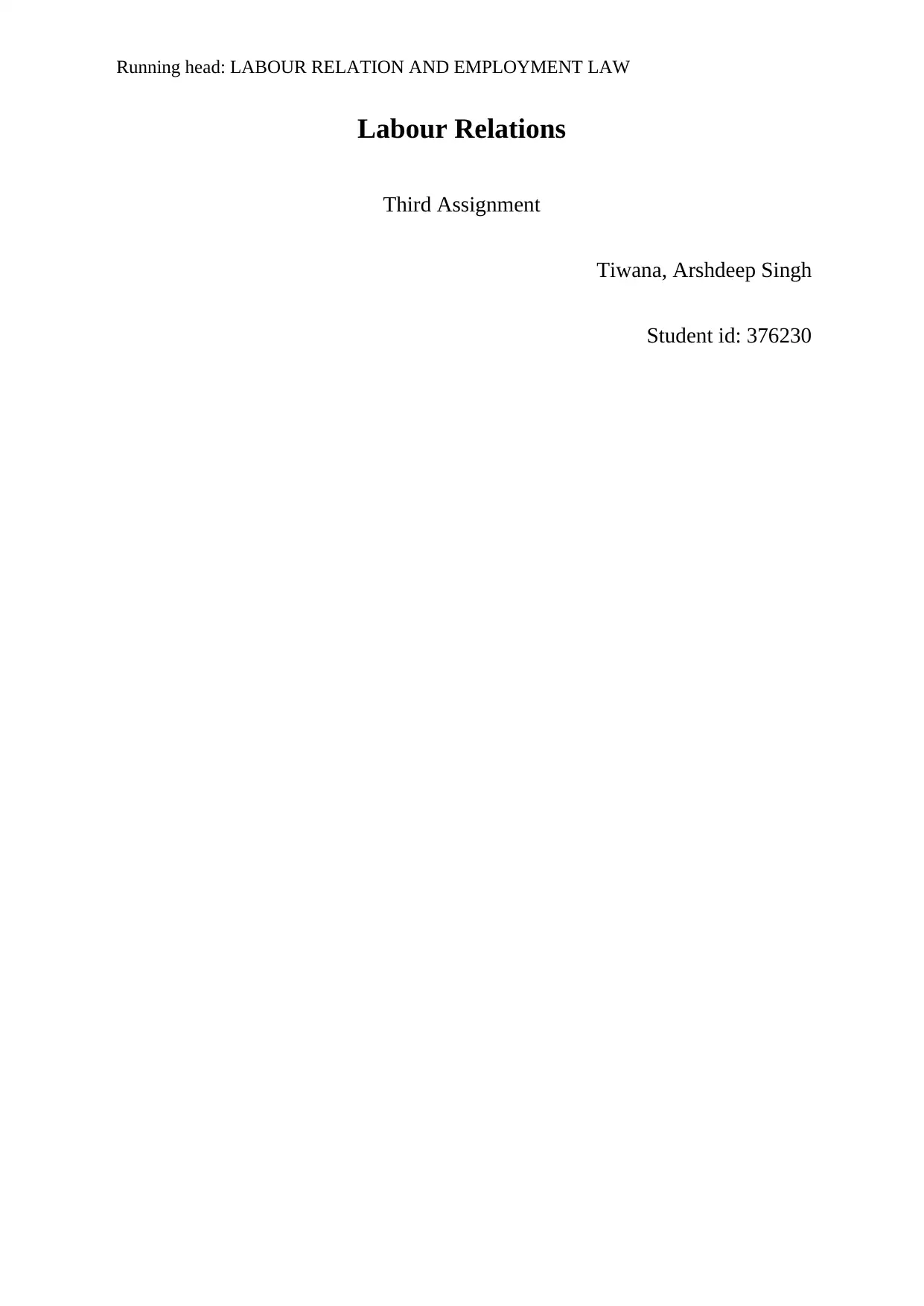
Running head: LABOUR RELATION AND EMPLOYMENT LAW
Labour Relations
Third Assignment
Tiwana, Arshdeep Singh
Student id: 376230
Labour Relations
Third Assignment
Tiwana, Arshdeep Singh
Student id: 376230
Paraphrase This Document
Need a fresh take? Get an instant paraphrase of this document with our AI Paraphraser
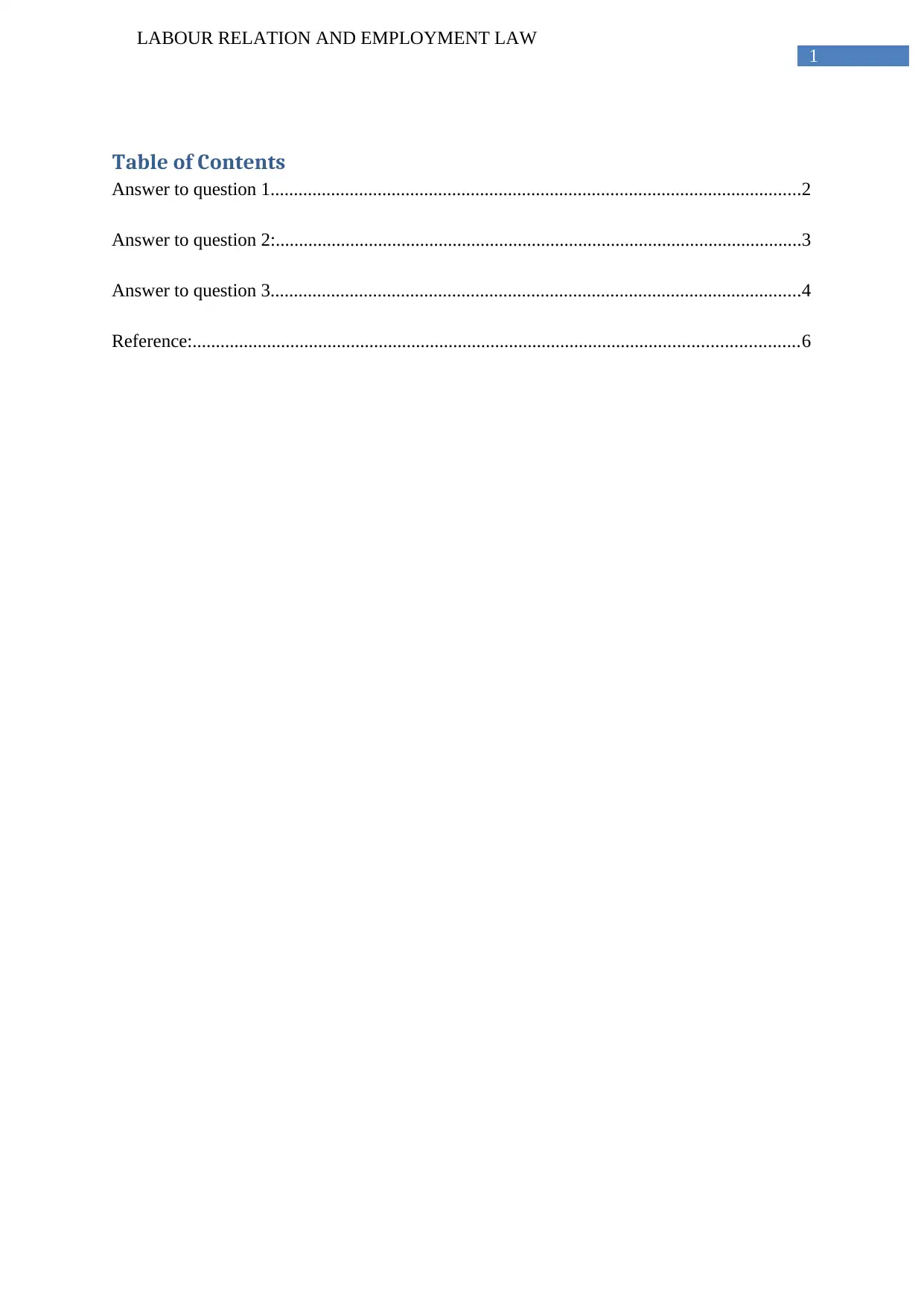
1
LABOUR RELATION AND EMPLOYMENT LAW
Table of Contents
Answer to question 1..................................................................................................................2
Answer to question 2:.................................................................................................................3
Answer to question 3..................................................................................................................4
Reference:..................................................................................................................................6
LABOUR RELATION AND EMPLOYMENT LAW
Table of Contents
Answer to question 1..................................................................................................................2
Answer to question 2:.................................................................................................................3
Answer to question 3..................................................................................................................4
Reference:..................................................................................................................................6
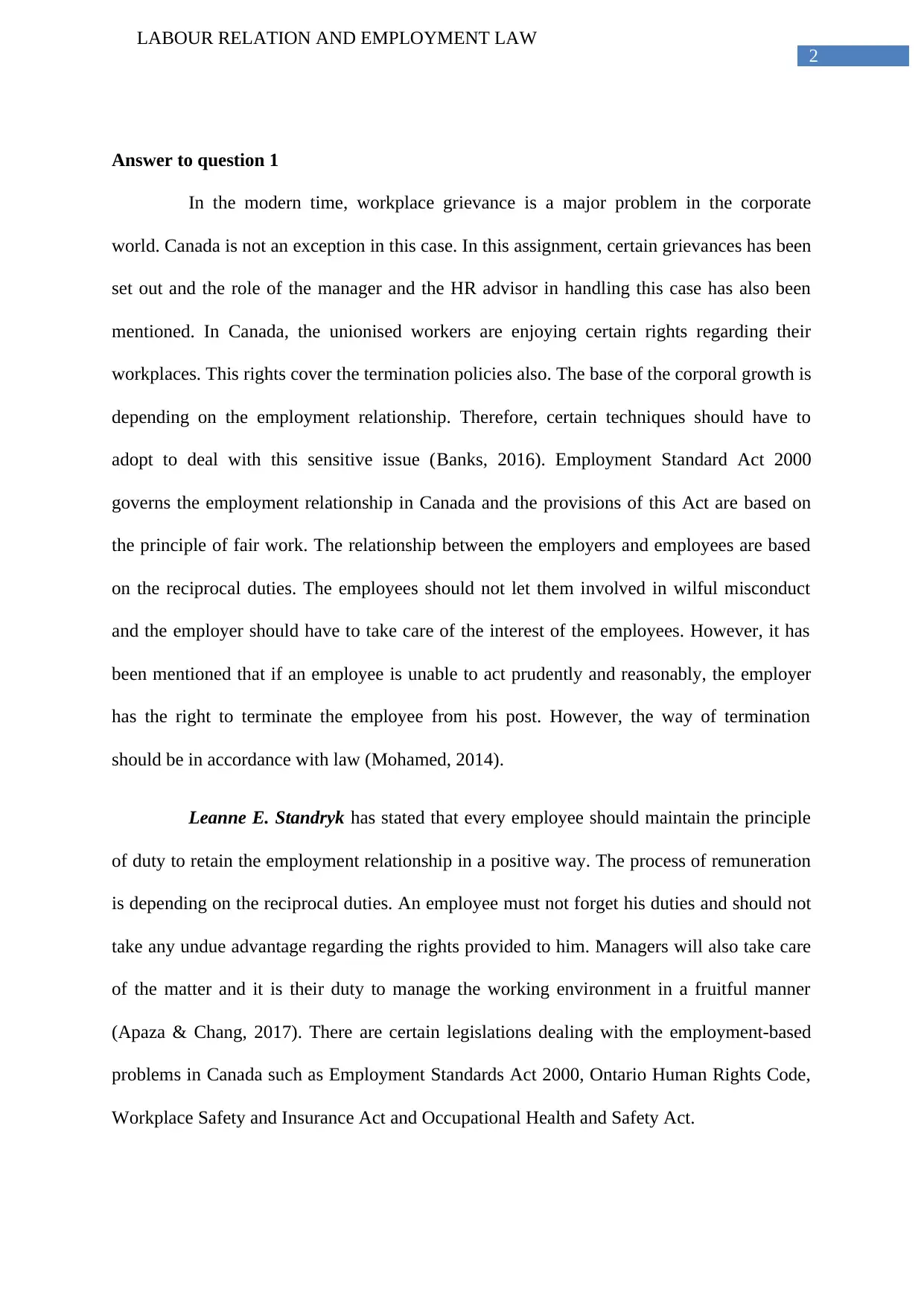
2
LABOUR RELATION AND EMPLOYMENT LAW
Answer to question 1
In the modern time, workplace grievance is a major problem in the corporate
world. Canada is not an exception in this case. In this assignment, certain grievances has been
set out and the role of the manager and the HR advisor in handling this case has also been
mentioned. In Canada, the unionised workers are enjoying certain rights regarding their
workplaces. This rights cover the termination policies also. The base of the corporal growth is
depending on the employment relationship. Therefore, certain techniques should have to
adopt to deal with this sensitive issue (Banks, 2016). Employment Standard Act 2000
governs the employment relationship in Canada and the provisions of this Act are based on
the principle of fair work. The relationship between the employers and employees are based
on the reciprocal duties. The employees should not let them involved in wilful misconduct
and the employer should have to take care of the interest of the employees. However, it has
been mentioned that if an employee is unable to act prudently and reasonably, the employer
has the right to terminate the employee from his post. However, the way of termination
should be in accordance with law (Mohamed, 2014).
Leanne E. Standryk has stated that every employee should maintain the principle
of duty to retain the employment relationship in a positive way. The process of remuneration
is depending on the reciprocal duties. An employee must not forget his duties and should not
take any undue advantage regarding the rights provided to him. Managers will also take care
of the matter and it is their duty to manage the working environment in a fruitful manner
(Apaza & Chang, 2017). There are certain legislations dealing with the employment-based
problems in Canada such as Employment Standards Act 2000, Ontario Human Rights Code,
Workplace Safety and Insurance Act and Occupational Health and Safety Act.
LABOUR RELATION AND EMPLOYMENT LAW
Answer to question 1
In the modern time, workplace grievance is a major problem in the corporate
world. Canada is not an exception in this case. In this assignment, certain grievances has been
set out and the role of the manager and the HR advisor in handling this case has also been
mentioned. In Canada, the unionised workers are enjoying certain rights regarding their
workplaces. This rights cover the termination policies also. The base of the corporal growth is
depending on the employment relationship. Therefore, certain techniques should have to
adopt to deal with this sensitive issue (Banks, 2016). Employment Standard Act 2000
governs the employment relationship in Canada and the provisions of this Act are based on
the principle of fair work. The relationship between the employers and employees are based
on the reciprocal duties. The employees should not let them involved in wilful misconduct
and the employer should have to take care of the interest of the employees. However, it has
been mentioned that if an employee is unable to act prudently and reasonably, the employer
has the right to terminate the employee from his post. However, the way of termination
should be in accordance with law (Mohamed, 2014).
Leanne E. Standryk has stated that every employee should maintain the principle
of duty to retain the employment relationship in a positive way. The process of remuneration
is depending on the reciprocal duties. An employee must not forget his duties and should not
take any undue advantage regarding the rights provided to him. Managers will also take care
of the matter and it is their duty to manage the working environment in a fruitful manner
(Apaza & Chang, 2017). There are certain legislations dealing with the employment-based
problems in Canada such as Employment Standards Act 2000, Ontario Human Rights Code,
Workplace Safety and Insurance Act and Occupational Health and Safety Act.
⊘ This is a preview!⊘
Do you want full access?
Subscribe today to unlock all pages.

Trusted by 1+ million students worldwide
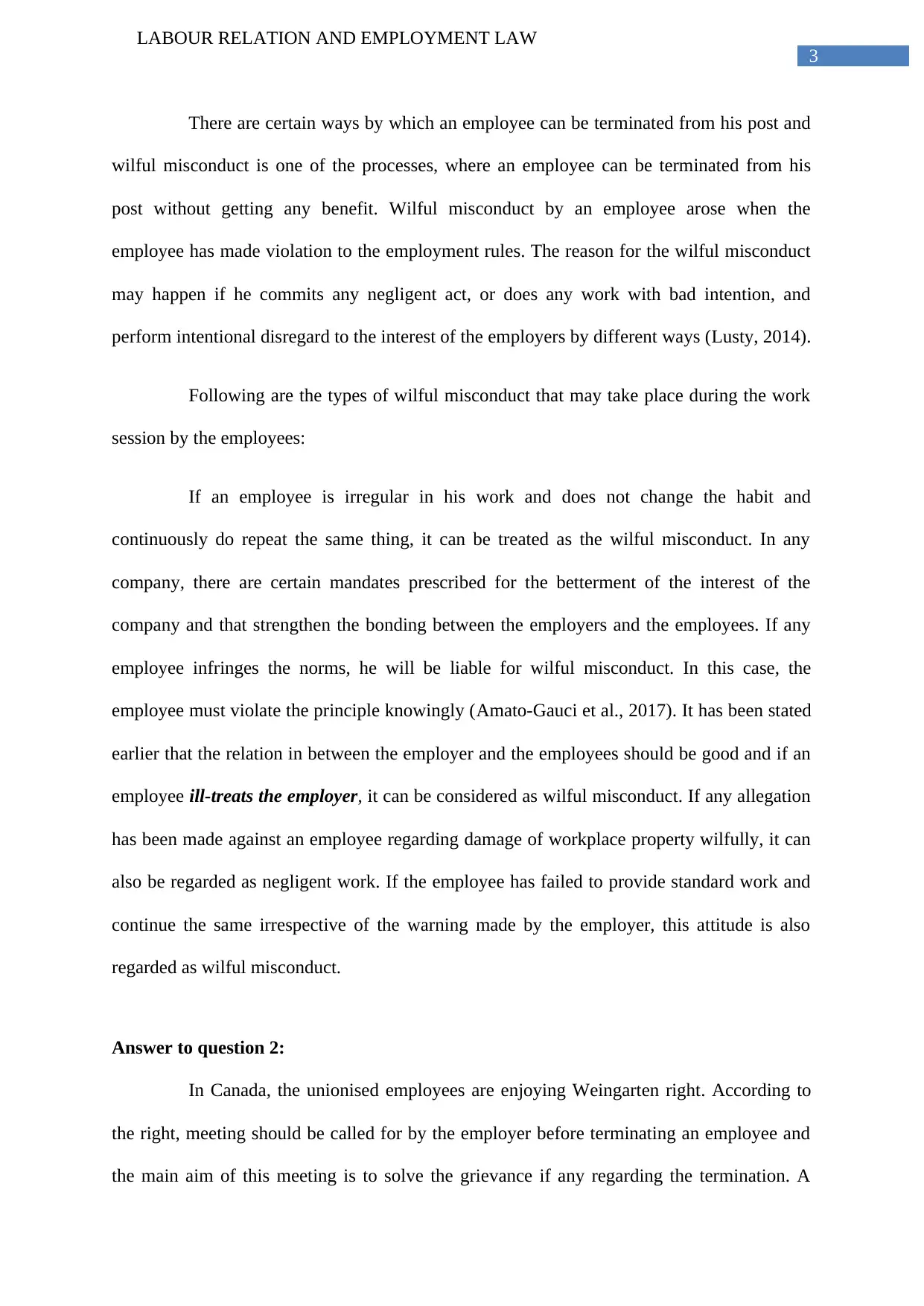
3
LABOUR RELATION AND EMPLOYMENT LAW
There are certain ways by which an employee can be terminated from his post and
wilful misconduct is one of the processes, where an employee can be terminated from his
post without getting any benefit. Wilful misconduct by an employee arose when the
employee has made violation to the employment rules. The reason for the wilful misconduct
may happen if he commits any negligent act, or does any work with bad intention, and
perform intentional disregard to the interest of the employers by different ways (Lusty, 2014).
Following are the types of wilful misconduct that may take place during the work
session by the employees:
If an employee is irregular in his work and does not change the habit and
continuously do repeat the same thing, it can be treated as the wilful misconduct. In any
company, there are certain mandates prescribed for the betterment of the interest of the
company and that strengthen the bonding between the employers and the employees. If any
employee infringes the norms, he will be liable for wilful misconduct. In this case, the
employee must violate the principle knowingly (Amato-Gauci et al., 2017). It has been stated
earlier that the relation in between the employer and the employees should be good and if an
employee ill-treats the employer, it can be considered as wilful misconduct. If any allegation
has been made against an employee regarding damage of workplace property wilfully, it can
also be regarded as negligent work. If the employee has failed to provide standard work and
continue the same irrespective of the warning made by the employer, this attitude is also
regarded as wilful misconduct.
Answer to question 2:
In Canada, the unionised employees are enjoying Weingarten right. According to
the right, meeting should be called for by the employer before terminating an employee and
the main aim of this meeting is to solve the grievance if any regarding the termination. A
LABOUR RELATION AND EMPLOYMENT LAW
There are certain ways by which an employee can be terminated from his post and
wilful misconduct is one of the processes, where an employee can be terminated from his
post without getting any benefit. Wilful misconduct by an employee arose when the
employee has made violation to the employment rules. The reason for the wilful misconduct
may happen if he commits any negligent act, or does any work with bad intention, and
perform intentional disregard to the interest of the employers by different ways (Lusty, 2014).
Following are the types of wilful misconduct that may take place during the work
session by the employees:
If an employee is irregular in his work and does not change the habit and
continuously do repeat the same thing, it can be treated as the wilful misconduct. In any
company, there are certain mandates prescribed for the betterment of the interest of the
company and that strengthen the bonding between the employers and the employees. If any
employee infringes the norms, he will be liable for wilful misconduct. In this case, the
employee must violate the principle knowingly (Amato-Gauci et al., 2017). It has been stated
earlier that the relation in between the employer and the employees should be good and if an
employee ill-treats the employer, it can be considered as wilful misconduct. If any allegation
has been made against an employee regarding damage of workplace property wilfully, it can
also be regarded as negligent work. If the employee has failed to provide standard work and
continue the same irrespective of the warning made by the employer, this attitude is also
regarded as wilful misconduct.
Answer to question 2:
In Canada, the unionised employees are enjoying Weingarten right. According to
the right, meeting should be called for by the employer before terminating an employee and
the main aim of this meeting is to solve the grievance if any regarding the termination. A
Paraphrase This Document
Need a fresh take? Get an instant paraphrase of this document with our AI Paraphraser
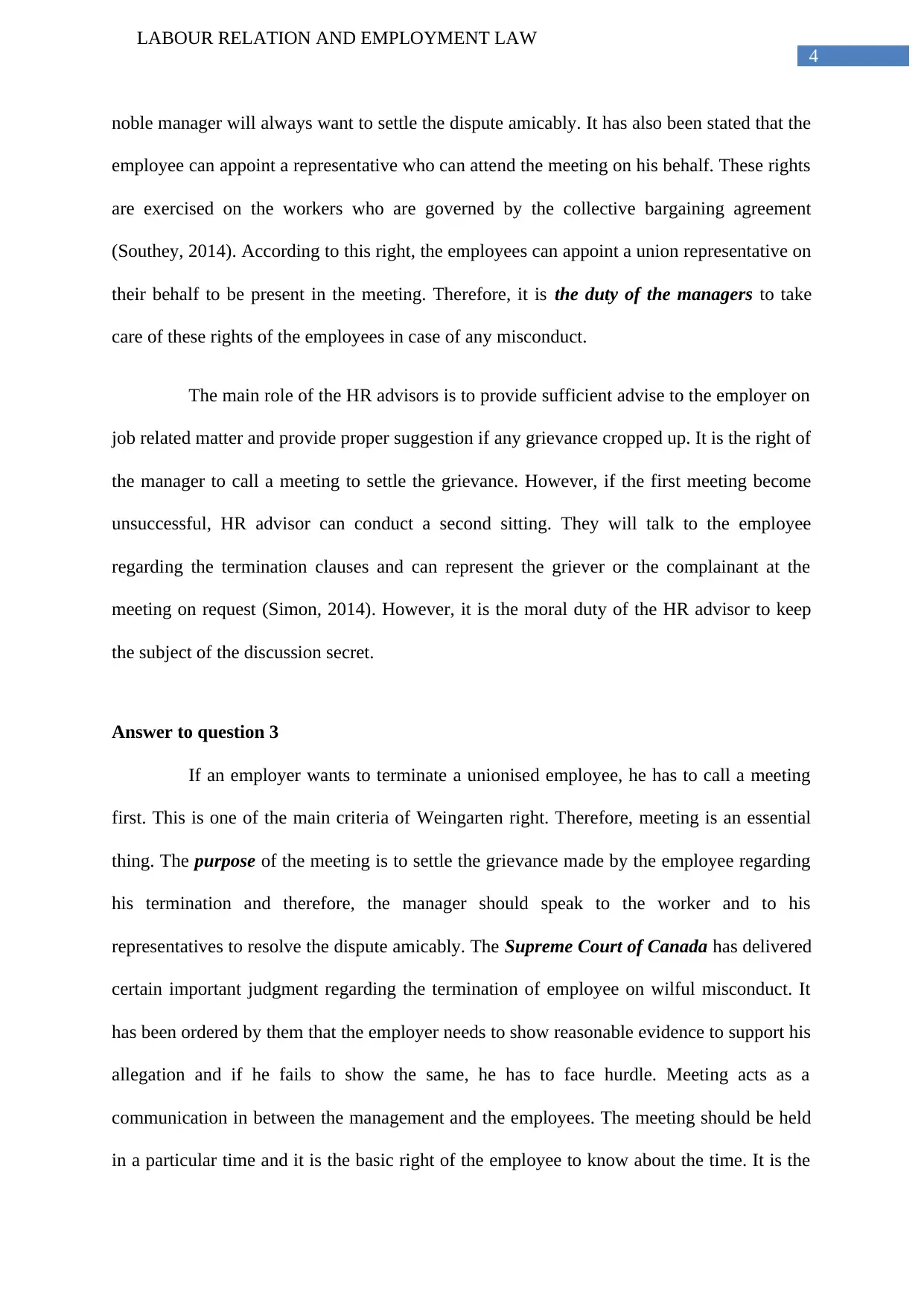
4
LABOUR RELATION AND EMPLOYMENT LAW
noble manager will always want to settle the dispute amicably. It has also been stated that the
employee can appoint a representative who can attend the meeting on his behalf. These rights
are exercised on the workers who are governed by the collective bargaining agreement
(Southey, 2014). According to this right, the employees can appoint a union representative on
their behalf to be present in the meeting. Therefore, it is the duty of the managers to take
care of these rights of the employees in case of any misconduct.
The main role of the HR advisors is to provide sufficient advise to the employer on
job related matter and provide proper suggestion if any grievance cropped up. It is the right of
the manager to call a meeting to settle the grievance. However, if the first meeting become
unsuccessful, HR advisor can conduct a second sitting. They will talk to the employee
regarding the termination clauses and can represent the griever or the complainant at the
meeting on request (Simon, 2014). However, it is the moral duty of the HR advisor to keep
the subject of the discussion secret.
Answer to question 3
If an employer wants to terminate a unionised employee, he has to call a meeting
first. This is one of the main criteria of Weingarten right. Therefore, meeting is an essential
thing. The purpose of the meeting is to settle the grievance made by the employee regarding
his termination and therefore, the manager should speak to the worker and to his
representatives to resolve the dispute amicably. The Supreme Court of Canada has delivered
certain important judgment regarding the termination of employee on wilful misconduct. It
has been ordered by them that the employer needs to show reasonable evidence to support his
allegation and if he fails to show the same, he has to face hurdle. Meeting acts as a
communication in between the management and the employees. The meeting should be held
in a particular time and it is the basic right of the employee to know about the time. It is the
LABOUR RELATION AND EMPLOYMENT LAW
noble manager will always want to settle the dispute amicably. It has also been stated that the
employee can appoint a representative who can attend the meeting on his behalf. These rights
are exercised on the workers who are governed by the collective bargaining agreement
(Southey, 2014). According to this right, the employees can appoint a union representative on
their behalf to be present in the meeting. Therefore, it is the duty of the managers to take
care of these rights of the employees in case of any misconduct.
The main role of the HR advisors is to provide sufficient advise to the employer on
job related matter and provide proper suggestion if any grievance cropped up. It is the right of
the manager to call a meeting to settle the grievance. However, if the first meeting become
unsuccessful, HR advisor can conduct a second sitting. They will talk to the employee
regarding the termination clauses and can represent the griever or the complainant at the
meeting on request (Simon, 2014). However, it is the moral duty of the HR advisor to keep
the subject of the discussion secret.
Answer to question 3
If an employer wants to terminate a unionised employee, he has to call a meeting
first. This is one of the main criteria of Weingarten right. Therefore, meeting is an essential
thing. The purpose of the meeting is to settle the grievance made by the employee regarding
his termination and therefore, the manager should speak to the worker and to his
representatives to resolve the dispute amicably. The Supreme Court of Canada has delivered
certain important judgment regarding the termination of employee on wilful misconduct. It
has been ordered by them that the employer needs to show reasonable evidence to support his
allegation and if he fails to show the same, he has to face hurdle. Meeting acts as a
communication in between the management and the employees. The meeting should be held
in a particular time and it is the basic right of the employee to know about the time. It is the
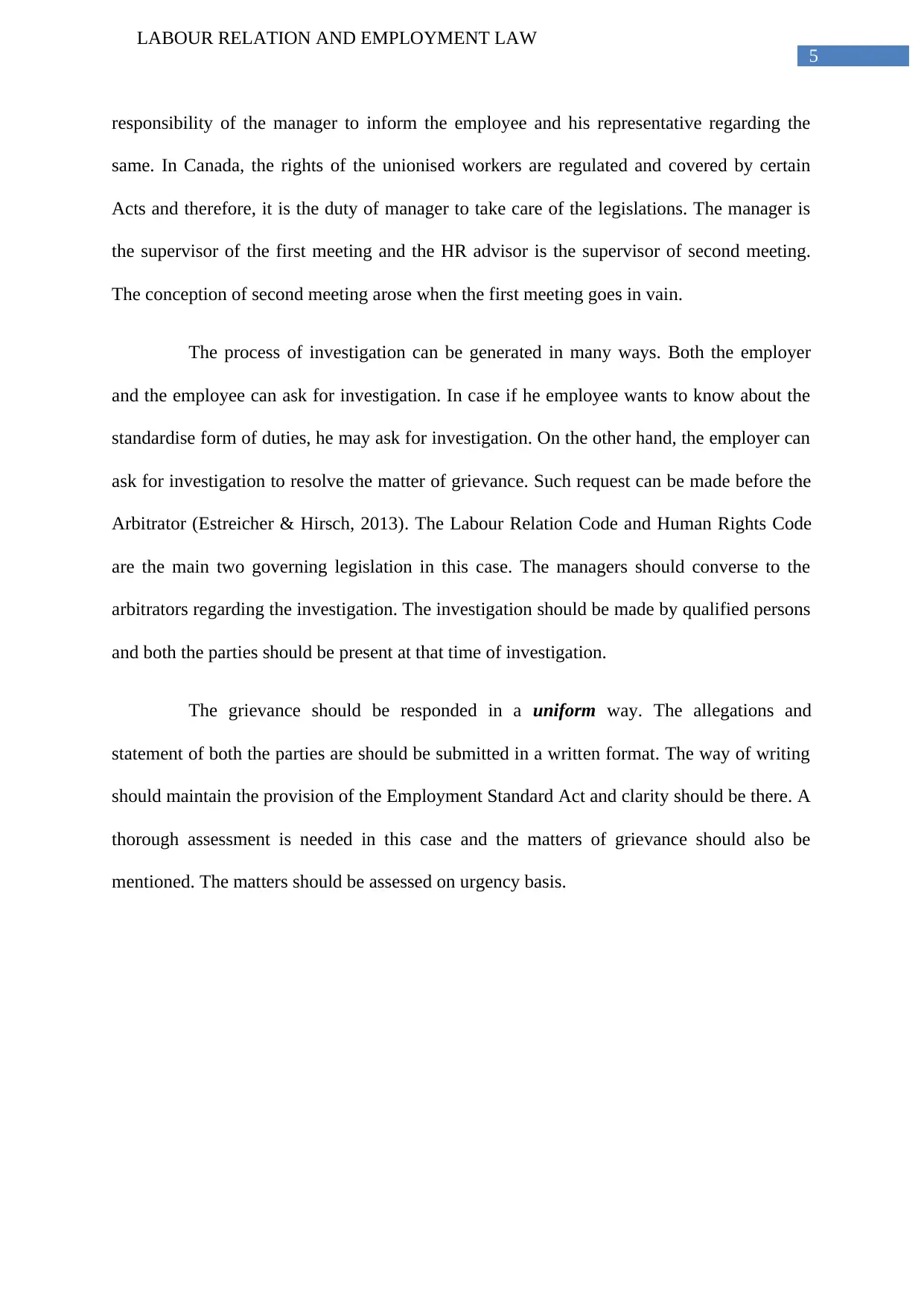
5
LABOUR RELATION AND EMPLOYMENT LAW
responsibility of the manager to inform the employee and his representative regarding the
same. In Canada, the rights of the unionised workers are regulated and covered by certain
Acts and therefore, it is the duty of manager to take care of the legislations. The manager is
the supervisor of the first meeting and the HR advisor is the supervisor of second meeting.
The conception of second meeting arose when the first meeting goes in vain.
The process of investigation can be generated in many ways. Both the employer
and the employee can ask for investigation. In case if he employee wants to know about the
standardise form of duties, he may ask for investigation. On the other hand, the employer can
ask for investigation to resolve the matter of grievance. Such request can be made before the
Arbitrator (Estreicher & Hirsch, 2013). The Labour Relation Code and Human Rights Code
are the main two governing legislation in this case. The managers should converse to the
arbitrators regarding the investigation. The investigation should be made by qualified persons
and both the parties should be present at that time of investigation.
The grievance should be responded in a uniform way. The allegations and
statement of both the parties are should be submitted in a written format. The way of writing
should maintain the provision of the Employment Standard Act and clarity should be there. A
thorough assessment is needed in this case and the matters of grievance should also be
mentioned. The matters should be assessed on urgency basis.
LABOUR RELATION AND EMPLOYMENT LAW
responsibility of the manager to inform the employee and his representative regarding the
same. In Canada, the rights of the unionised workers are regulated and covered by certain
Acts and therefore, it is the duty of manager to take care of the legislations. The manager is
the supervisor of the first meeting and the HR advisor is the supervisor of second meeting.
The conception of second meeting arose when the first meeting goes in vain.
The process of investigation can be generated in many ways. Both the employer
and the employee can ask for investigation. In case if he employee wants to know about the
standardise form of duties, he may ask for investigation. On the other hand, the employer can
ask for investigation to resolve the matter of grievance. Such request can be made before the
Arbitrator (Estreicher & Hirsch, 2013). The Labour Relation Code and Human Rights Code
are the main two governing legislation in this case. The managers should converse to the
arbitrators regarding the investigation. The investigation should be made by qualified persons
and both the parties should be present at that time of investigation.
The grievance should be responded in a uniform way. The allegations and
statement of both the parties are should be submitted in a written format. The way of writing
should maintain the provision of the Employment Standard Act and clarity should be there. A
thorough assessment is needed in this case and the matters of grievance should also be
mentioned. The matters should be assessed on urgency basis.
⊘ This is a preview!⊘
Do you want full access?
Subscribe today to unlock all pages.

Trusted by 1+ million students worldwide
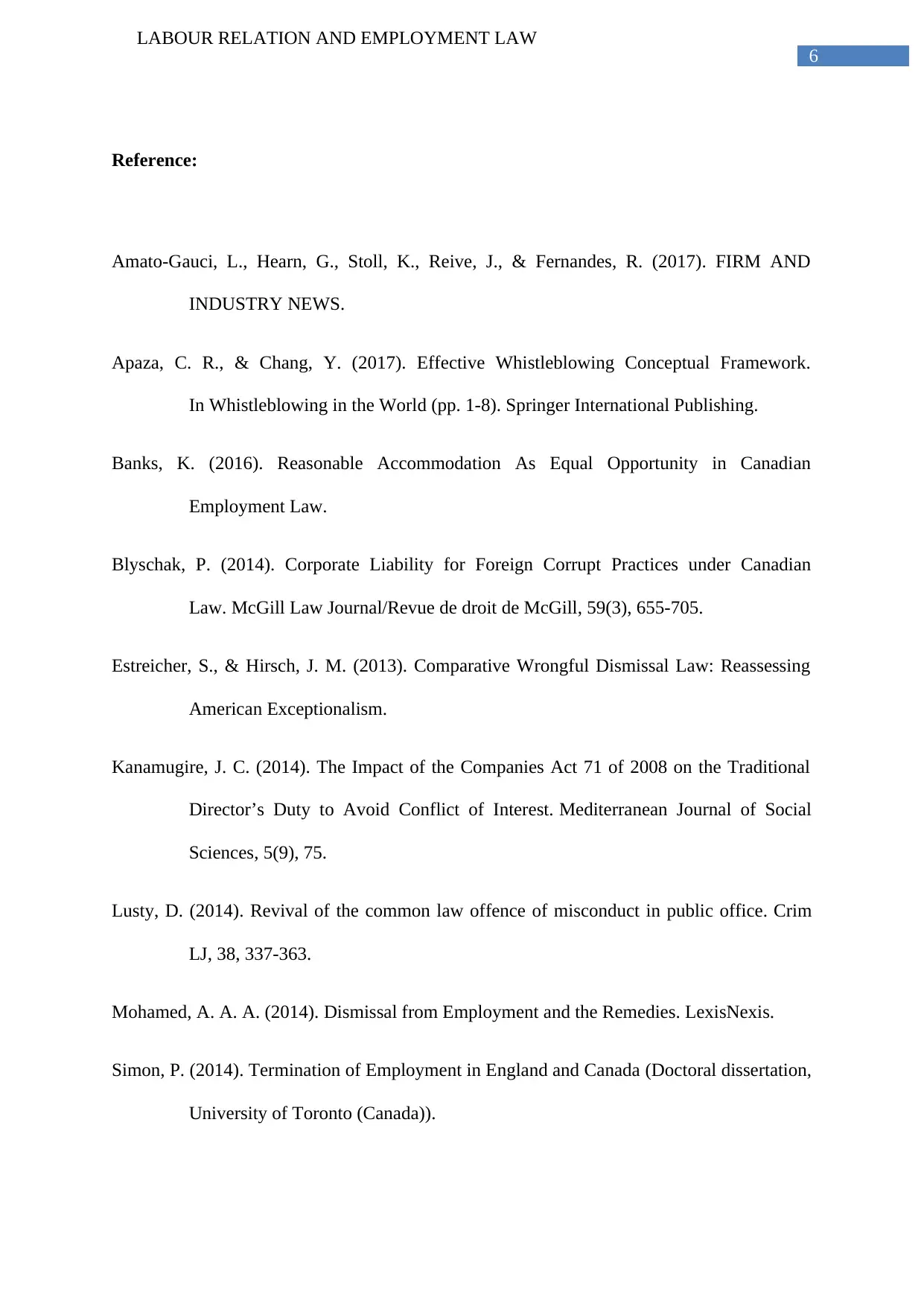
6
LABOUR RELATION AND EMPLOYMENT LAW
Reference:
Amato-Gauci, L., Hearn, G., Stoll, K., Reive, J., & Fernandes, R. (2017). FIRM AND
INDUSTRY NEWS.
Apaza, C. R., & Chang, Y. (2017). Effective Whistleblowing Conceptual Framework.
In Whistleblowing in the World (pp. 1-8). Springer International Publishing.
Banks, K. (2016). Reasonable Accommodation As Equal Opportunity in Canadian
Employment Law.
Blyschak, P. (2014). Corporate Liability for Foreign Corrupt Practices under Canadian
Law. McGill Law Journal/Revue de droit de McGill, 59(3), 655-705.
Estreicher, S., & Hirsch, J. M. (2013). Comparative Wrongful Dismissal Law: Reassessing
American Exceptionalism.
Kanamugire, J. C. (2014). The Impact of the Companies Act 71 of 2008 on the Traditional
Director’s Duty to Avoid Conflict of Interest. Mediterranean Journal of Social
Sciences, 5(9), 75.
Lusty, D. (2014). Revival of the common law offence of misconduct in public office. Crim
LJ, 38, 337-363.
Mohamed, A. A. A. (2014). Dismissal from Employment and the Remedies. LexisNexis.
Simon, P. (2014). Termination of Employment in England and Canada (Doctoral dissertation,
University of Toronto (Canada)).
LABOUR RELATION AND EMPLOYMENT LAW
Reference:
Amato-Gauci, L., Hearn, G., Stoll, K., Reive, J., & Fernandes, R. (2017). FIRM AND
INDUSTRY NEWS.
Apaza, C. R., & Chang, Y. (2017). Effective Whistleblowing Conceptual Framework.
In Whistleblowing in the World (pp. 1-8). Springer International Publishing.
Banks, K. (2016). Reasonable Accommodation As Equal Opportunity in Canadian
Employment Law.
Blyschak, P. (2014). Corporate Liability for Foreign Corrupt Practices under Canadian
Law. McGill Law Journal/Revue de droit de McGill, 59(3), 655-705.
Estreicher, S., & Hirsch, J. M. (2013). Comparative Wrongful Dismissal Law: Reassessing
American Exceptionalism.
Kanamugire, J. C. (2014). The Impact of the Companies Act 71 of 2008 on the Traditional
Director’s Duty to Avoid Conflict of Interest. Mediterranean Journal of Social
Sciences, 5(9), 75.
Lusty, D. (2014). Revival of the common law offence of misconduct in public office. Crim
LJ, 38, 337-363.
Mohamed, A. A. A. (2014). Dismissal from Employment and the Remedies. LexisNexis.
Simon, P. (2014). Termination of Employment in England and Canada (Doctoral dissertation,
University of Toronto (Canada)).
Paraphrase This Document
Need a fresh take? Get an instant paraphrase of this document with our AI Paraphraser
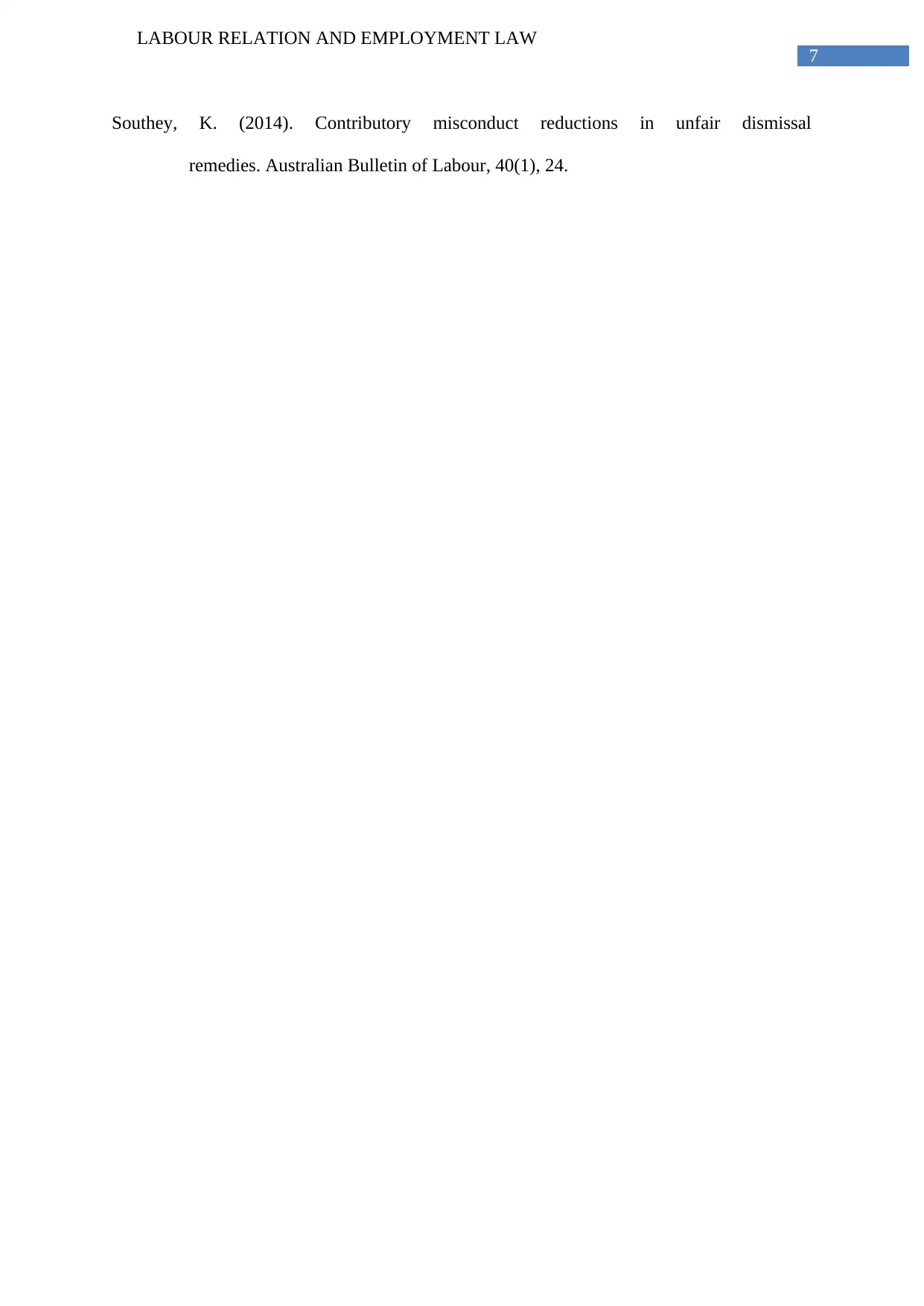
7
LABOUR RELATION AND EMPLOYMENT LAW
Southey, K. (2014). Contributory misconduct reductions in unfair dismissal
remedies. Australian Bulletin of Labour, 40(1), 24.
LABOUR RELATION AND EMPLOYMENT LAW
Southey, K. (2014). Contributory misconduct reductions in unfair dismissal
remedies. Australian Bulletin of Labour, 40(1), 24.
1 out of 8
Related Documents
Your All-in-One AI-Powered Toolkit for Academic Success.
+13062052269
info@desklib.com
Available 24*7 on WhatsApp / Email
![[object Object]](/_next/static/media/star-bottom.7253800d.svg)
Unlock your academic potential
Copyright © 2020–2025 A2Z Services. All Rights Reserved. Developed and managed by ZUCOL.





